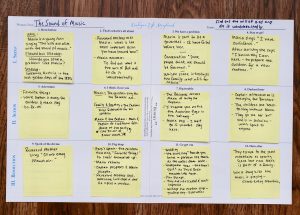
If there is one technique that has helped me more than anything to be a better writer and it is this: learning how to storyboard. When stories veer off course, it can kill otherwise great tales. I know, this happened to me after finishing an entire manuscript. I had to deconstruct it and start over. Do you know how time consuming and frustrating that was? But boy, what an education. This technique will help you avoid that pain and feel confident in how to start and end your story, which big moments to highlight and where to cut. I can’t wait for you to try it, and see how this storyboarding process sparks creativity. It is exhilarating.
6 ways learning how to storyboard will make you a better writer:
- Triggers electric currents of creativity.
- Helps you know what to look for in a true-life tale (or fiction, of course). It becomes intuitive with practice.
- Guides editing to flesh out key moments and trim the boring parts.
- Acts as a map, keeping your story from veering off course.
- Gets you unstuck, especially in knowing where to start and end the story.
- Gives you confidence your story will satisfy.
Storyboarding works beautifully for true tales
It might seem that when writing true stories, the formula would not work since we are not making up the details. In other words, we don’t have the convenience of making the story conform to the template like Hollywood screenwriters can do. But it does work without forcing it and here is my theory as to why.
Printable Storyboard Template

Storyboard any book, memoir, biography, or family history tale with our free printable template. It just might save your story.
The storyboard reflects the patterns of life
First, I have come to believe that tried-and-true storylines simply mirror patterns that play out again and again in real life. Our brains are wired to respond to the cadence of stories we recognize in the people we know, we gravitate to stories that ring true to lived experience. In other words, the template is a reflection of life, not the other way around. Once you know what to look for, it is an exhilarating feeling to see that your own true stories naturally hit all at the right beats, in all the right places. You tell the truth without embellishment and still hit emotional notes that satisfy readers. Hey look! The elements are all right here, naturally…And here…and here. At least, that has been my experience.
Related article: Is truth better than fiction?
The storyboard helps memoir and biography writers know what to emphasize and what to cut. In short, telling a gripping story is not a matter of fictionalizing what happened, but a matter of trimming the fat. Also, we have found in our oral history work that when we learn the beats, we intuitively begin asking better interview questions that draw out compelling moments in a person’s life.
Related article: Learning Story Structure by storyboarding The Sound of Music

Simplifying the storyboard template
I loved the Hollywood method, but found there was too much jargon and it was too complicated for most writers of memoirs, short stories, and family history tales. I set out to modify the template from Hollywood into language that made sense for true stories and simplify it. I quickly learned that I needed to make it more straightforward so beginners can use it, but still robust enough for complex stories and full books. I love using sticky notes, so my template is sized for sticky notes. Quick reminders of what should happen in each “beat” are printed on the template, and you put your sticky note over the top.
Now the template is clean, using titles that make intuitive sense.
The storyboard structure
The template breaks the story into three acts—think of it as beginning, middle and end. Then there are 12 key “beats.” (Note: I’ve commandeered the Hollywood term “beats” to mean something similar but I don’t use it in the same technical way that artists draw a storyboard).
The storyboard template expands and contracts for short stories and full books
These 12 beats work for short stories and full books alike. In a full book, a “beat” might run for an entire chapter or more, containing multiple scenes. In a short story a beat might simply be an emotional note that we can hit in a single paragraph. Finally, each beat has a name that makes it easy to remember. The final template is two standard sheets of paper that fit together. This is the same size I have been using for years and it gives enough room to work without sacrificing portability. If I were not using the pre-printed templates, I would want to print on card stock so it has weight.
You can use the template in multiple ways:
- Print the free template (blank form) and write directly on the storyboard
- Print it with the text showing to remind you what the beat should be. Then, put a sticky note over each square and write on the notes. This is how I do it. To me, it’s important to iterate multiple rounds of edits on individual beats without having to erase or start over on the whole template. I have worked from the same storyboard for years at a time and this makes it slick to edit and update.
- You can watch a tutorial on how to use this template here: Storyboarding True Life Stories I take you through the plot of Toy Story and show you how every beat is feature in this animated classic.

You can still be flexible – even with a template
Before delving further into how to storyboard, there is something I always tell my students. Don’t worry about it! I will often write a first draft in free-form style before storyboarding and just let the story surprise me. I think of creativity as a discovery process and not something to force. Sometimes if I am making a video script I will storyboard it right from the beginning, but with other stories I might write a full draft before using the storyboard. This process then pinpoints weak spots or places where I meander.
Don’t think you have to be rigid about what goes where on the storyboard at first. Also, sometimes beats will be shorter or longer, or maybe missing altogether. Maybe they are out of order or will overlap. This is a guide and it’s meant to spark your creativity and be fun, not construct you. In other words, there is a time to let ‘er rip in your writing, and there is a time to analyze. The storyboard is for analysis.
Here is how to storyboard with 12 beats:
Act I. “Setup”
1. Hero before. Introduce flawed but likable hero at home, work, and having fun. Set the scene in time, place and mood.
2. That’s what it’s all about. Introduce theme through a conversation. Friends debate a central idea.
3. We have a problem. Bam! Something happens and protagonist must change or die. Every tale needs a central conflict or tangible goal.
4. Stay or go? The choice: continue life or embark on a journey? Our hero might resist but status quo is not viable. A leap of faith, and we go down the rabbit hole.
Act II. “Action”
5. Adventure: Our hero and cast of friends explore a new world. This might take multiple scenes and can be serious or playful in tone.
6. I think I love you: The tangible goal intersects with a new love interest. What hero wants vs. what hero needs.
*Betwixt: Tension mounts in scenes around the middle. Kiss the girl. Our hero debuts to the world. False victory or defeat. Stakes are raised and bad guys plan an attack. Note that this is not its own beat. These emotional notes are hit around this time in Act II, just be aware of this demarcation in your story.
7. Big trouble. Our hero’s flaws are in full bloom. Dubious plans backfire. Relationships splinter. The bad guys pounce. We sense mortality when someone dies. Fear.
(Read related article: Is yours a redemption story?)
8. Darkest hour. Something terrible happens and our hero is ready to give up. Despair.
III. Resolution
9. Spark of the divine: Our hero has a spiritual awakening and sees the answer. Dawn breaks with fresh hope. We are all-in again.
10. Dig deep. Friends make amends. Underdogs gather resources and hatch an impossible plan. A time clock adds pressure.
11. Go get ‘em. Race to the airport. Sneak past the guards. Then, the plan goes awry. Hero must improvise and finally changes. Victory!
12. Hero after. Our hero is transformed in 180-degree growth from the start. We see a mirror opposite from the flawed “here before.”
Printable Storyboard Template

Storyboard any book, memoir, biography, or family history tale with our free printable template. It just might save your story.
Please fill out the form above and I will be happy to email you the storyboard template for free. Thank you for subscribing! We email quick tips & inspiration on how to tell your story every-other-week. Okay, I know that is a very high level overview for how to storyboard.
How to storyboard a 90-second video
Watch the source video first:
And here is another full tutorial article that walks through the storyboard using The Sound of Music and the children’s book The Very Hungry Caterpillar: Click here to read another article about story structure and more examples of how to storyboard

Rhonda Lauritzen is a professional biographer with multiple published books and a regular speaker at conferences. She has an MBA from the University of Utah and served as CEO of her family business, working alongside six brothers. Her writing journey began with her parents’ family business saga, and in 2016, she founded Evalogue.Life. Since then, Rhonda has professionally told the stories of families, cities, and nonprofits. She believes that when you tell your story, it changes the ending. Her next book will be distributed by Simon & Schuster December 10, 2024: Creative Insecurity: Lean Into the Unknown and Unleash Your Inner Misfit.
She and her husband Milan restored an old Victorian in Ogden and work together, weaving family and business together. Check out her latest book Remember When, the inspiring Norma and Jim Kier story.
Disclaimer: This page contains affiliate links which means if you purchase some of the products we mention by using our links, we make a commission. Be assured that I’m only sharing the methods I actually use, but I do appreciate when you buy with my links because it helps fund articles like this one.
Printable Storyboard Template

Storyboard any book, memoir, biography, or family history tale with our free printable template. It just might save your story.


Pingback: Animoto Review - Tell Your Story with Evalogue.Life
Pingback: Is Yours a Redemption Story? - Tell Your Story with Evalogue.Life
Pingback: Story structure - Tell Your Story with Evalogue.Life
Pingback: A Change of Plan: A Birth Story - Ali McJoy
Did I use too many spaces?
1st thought: I have a mind chuck full of memories but I don’t want to bite off more than I can chew. Will using a storyboard control that?
2nd thought: I like being able to cut & paste on the computer but sometimes I can’t stop. Is it possible to use paper, pencil, & computer?
It’s late & I’m so tired that I’ve forgotten my 3rd thought. Is there still hope?
Nancy, I totally get it! Well, I like to think a storyboard is the solution to everything, ha. My advice is to jot down quick reminders for as many of those memories as you possibly can. Sit down, and just write fast and furious, making a list of every memory that comes to mind you want to write about. Keep an ongoing list and add to it whenever another one comes to mind. That way, you have a placeholder for it all. Then, focus on one moment at a time. Start with one vivid memory that is tugging at your heart and write about that. The storyboard will help you tell each vignette/story in a way that is compelling for readers and is fun to write. When you have finished with that one, go on to the next and the next and the next. At some point, if you want to write a full book, you can string them together in an over-arching narrative using the storyboard. But you’ll get too overwhelmed if you start with the idea of the big picture. Start with individual stories first because that’s what people want to read and that’s where the life is. By the way, I am considering making a PDF template but haven’t done so yet. I have doubts about whether it will spark the creativity so for now, I urge you to give the storyboard a try using sticky notes.
This looks like a lot of fun. Love writing stories, I think I would love writing family history stories. Your article is great and makes it look simple.
Thank you!
Brenda, it IS fun! That feeling of excitement when mapping a personal story is hard to beat. I hope the template helps spark your own creativity. And yes, you would love writing family stories but fair warning, it can be addicting. You just never know when and how one of those stories will tug at you for attention. Best wishes. Thanks for your comment.
Awesome ideas, definitely gonna try.
thank you for this post! my significant other is attempting his first novel and this information is so helpful!
Lacey, I really hope the method helps him. It made a world of difference for me, and lately it has been a blast helping novelists storyboard their books. Best wishes to him! It’s a worthy pursuit, writing a first book.
Thank you for sharing your ideas after going through all the trial and error yourself.
Elizabeth, it makes my heart happy when that learning curve can help somebody else! I guess it feels good to repay the generosity that other people gave me when I was first starting out. Thanks for your kind comment.
Pingback: Remember who you are. Help your kids put down their phones and remember.
Looks like a lot of work. But I can see how you made it easy too.
Pingback: We All Have Stories: Remembering - Ali McJoy
I would love to try an electronic template. I am forever erasing and rewriting. It would be easy to move notes around and add to them with cut and paste.
Ruth, terrific! I will email it to you, and then welcome feedback on how it works for you. I’ve been following some research that says the brain seems to process information differently using a pen and paper vs. when we type notes, so I am very curious if the fillable PDF sparks the same creativity in you. There is definitely a case for efficiency too, which is why we type directly in the computer now rather than writing longhand on lined paper.
Pingback: Animoto Review - Tell Your Story with Evalogue.Life